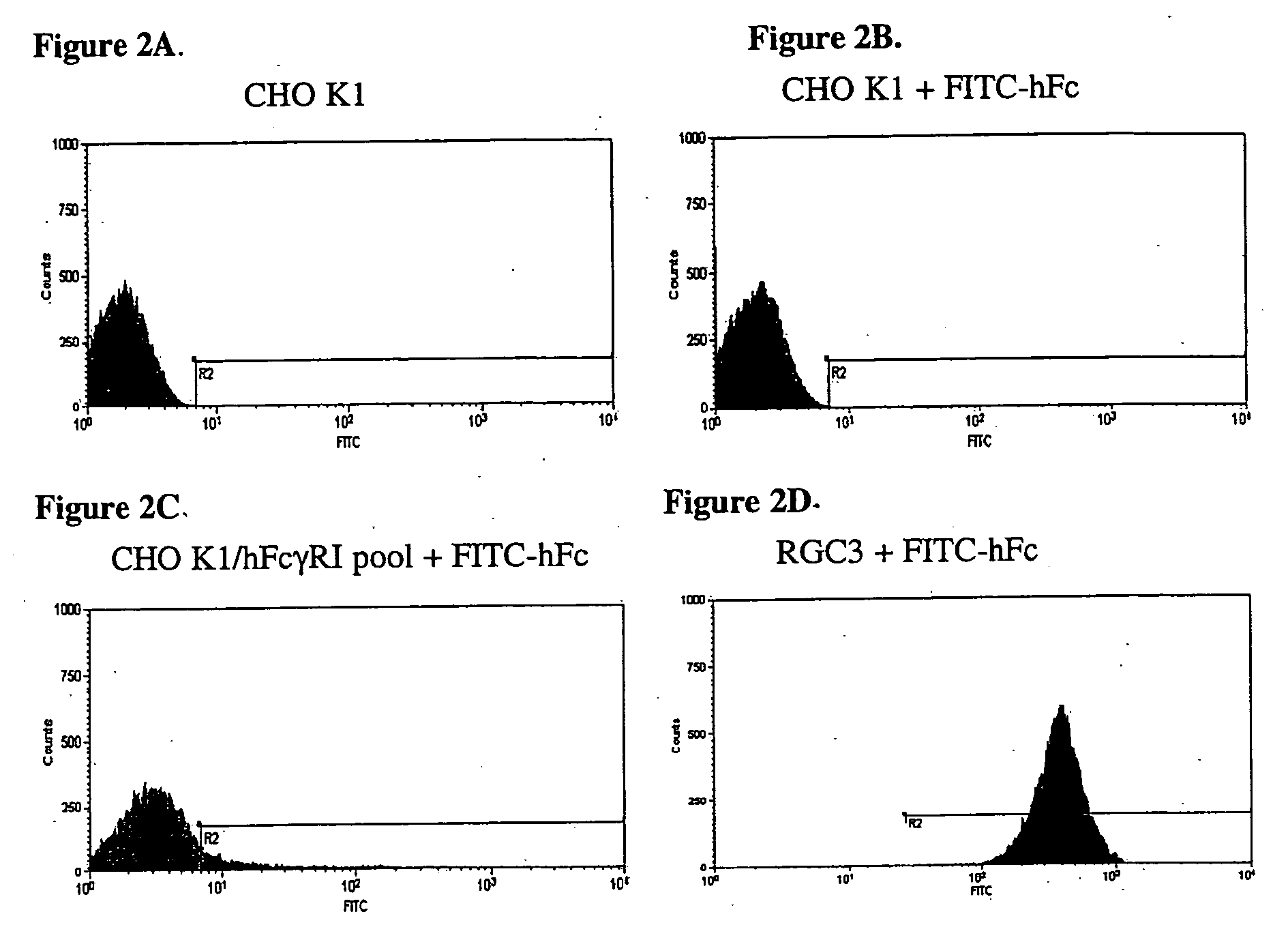Isolating cells expressing secreted proteins
a technology of secreted proteins and cells, applied in the field of identification and isolating cells, can solve the problems of insufficient available methods, risks of losing high expression cells, laborious procedures, etc., and achieve the effect of facilitating the detection and/or isolating of cells
- Summary
- Abstract
- Description
- Claims
- Application Information
AI Technical Summary
Benefits of technology
Problems solved by technology
Method used
Image
Examples
example 1
[0143] Construction of pTE084: pTE084 was constructed by ligating the 1,436 bp Xba I fragment from pCAE100 that encodes the human FcγRI (hFcγRI; GenBank accession number M21091) into the Xba I site of pRG821. The orientation of hFcγRI in desirable plasmids resulting from the ligation was examined by restriction mapping with Not I, Pst I, Eco RI, and Stu I. pTE084 was designed for the high level expression of hFcγRI, the high affinity cell surface receptor for the Fc domain of human IgG. It contains two independent expression cassettes. One cassette is a hFcγRI gene driven by the CMV-MIE promoter, and the second cassette is the neomycin phosphotransferase II (npt) gene, which confers resistance to G418, driven by the SV40 late promoter.
[0144] Construction of a CHO K1 derivative that expresses hFcγRI:
[0145] CHO K1 cells (4×106) were transfected with pTE084 using Lipofectamine™ (Life Technologies; Rockville, Md.) following manufacturer's suggestions. The cells were placed in the cult...
example 2
[0148] Cell surface fluorescence correlates with the expression level of 4SC622: RGC1 cells (4×106) were transfected with pEE14.1-622 and a pool of stable transfectants was obtained after selection for 2 weeks in medium comprised of 10% dialyzed fetal bovine serum, 90% glutamine-free Dulbecco's modified eagle's medium, 1×GS supplement, and 25 uM MSX (All reagents were from JRH Biosciences, Lenexa, Kans.). Rat IgG was added to the culture medium to 1 mg / ml 18 hours prior to immunostaining. The cells were trypsinized, washed with PBS, and stained with 1.5 ug / ml of a polyclonal FITC-conjugated anti-human IgG (H+L) F(ab′)2 fragment (Jackson ImmunoResearch Laboratories) for one hour at room temperature following procedures as described for FITC-hFc staining in Example 1. Cell staining was then analyzed by flow cytometry. The distribution of fluorescence suggested that the selected pool contained cells with a wide range of 4SC622 expression levels (FIG. 6). Cells in the top 3% (R3 bracket...
example 3
[0149] Isolation of Expression Clones in RGC1:
[0150] IL-4 Trap. To directly demonstrate the efficiency in generating clonal cell lines with high level secreted protein production by our methodology, clonal 4SC622 producing cell lines were generated from RGC1. RGC1 cells (4×106) were transfected with pEE14.1-622, and selected for two weeks with 25 μM MSX to obtain a pool of stable transfectants. MSX-resistant cells were pooled and incubated with 1 mg / ml human IgG for 18 hours, prior to staining with PE-AG184. Six cells from the top 5% gate, as determined by flow cytometry analysis of cell surface 4SC622 staining, were isolated and expanded. 4SC622 production from the six clonal lines was determined and compared to 4SC622 production from clones obtained by hand-picking selected colonies followed by dilution cloning and amplification. One RGC1-derived clone, RGC4, produced 4SC622 at 12 pg / cell / day (FIG. 7). This level is similar to that of the best 4SC622 producer isolated by hand-pic...
PUM
| Property | Measurement | Unit |
|---|---|---|
| degree of heterogeneity | aaaaa | aaaaa |
| fluorescent protein | aaaaa | aaaaa |
| stability | aaaaa | aaaaa |
Abstract
Description
Claims
Application Information
 Login to View More
Login to View More - R&D
- Intellectual Property
- Life Sciences
- Materials
- Tech Scout
- Unparalleled Data Quality
- Higher Quality Content
- 60% Fewer Hallucinations
Browse by: Latest US Patents, China's latest patents, Technical Efficacy Thesaurus, Application Domain, Technology Topic, Popular Technical Reports.
© 2025 PatSnap. All rights reserved.Legal|Privacy policy|Modern Slavery Act Transparency Statement|Sitemap|About US| Contact US: help@patsnap.com



